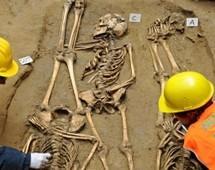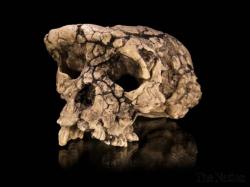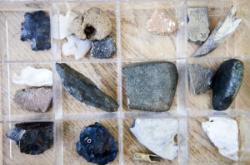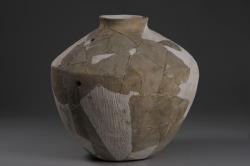INSTITUT SUPERIEUR D'ANTHROPOLOGIE
INSTITUTE OF ANTHROPOLOGY
ONLINE COURSES / COURS A DISTANCE
SPRING TERM : APRIL 2014
REGISTER NOW
ANGOLA -  Mbanza Congo- The discovery of archaeological trace for basis in the Mbanza Congo city candidature as the world heritage is the purpose of the archaeological studies happening in this locality, under the guidance of the Ministry of Culture. In this second mission, which started on 21 January 2013 to end on 13 February this year, the expert team made up of Angolan and foreign specialists dug and found a wall that might be considered a great structure (Royal Palace) connected to the former Congo kingdom. According to the coordinator of the project "Mbanza Congo, city to be unearthed for preservation", the Angolan archaeologist Sónia Domingos said to Angop on Wednesday that the discovered walls in the site named Tadi-Dia-Bukikua is made up of two compartments. The official said that the team of specialists will dig the whole surface of the area, followed by the 3D reconstitution of the structure found to know its typology, in order to elaborate a model to be used by tourists
Mbanza Congo- The discovery of archaeological trace for basis in the Mbanza Congo city candidature as the world heritage is the purpose of the archaeological studies happening in this locality, under the guidance of the Ministry of Culture. In this second mission, which started on 21 January 2013 to end on 13 February this year, the expert team made up of Angolan and foreign specialists dug and found a wall that might be considered a great structure (Royal Palace) connected to the former Congo kingdom. According to the coordinator of the project "Mbanza Congo, city to be unearthed for preservation", the Angolan archaeologist Sónia Domingos said to Angop on Wednesday that the discovered walls in the site named Tadi-Dia-Bukikua is made up of two compartments. The official said that the team of specialists will dig the whole surface of the area, followed by the 3D reconstitution of the structure found to know its typology, in order to elaborate a model to be used by tourists
http://allafrica.com/stories/201402121395.html?viewall=1
ITALIE –  Florence - A building site near the Uffizi museum has uncovered what archeologists believe could be a mass grave dating back to the sixth or seventh century AD, possibly during a plague. The dig found 60 bodies laid out head-to-toe in a manner that could indicate hasty burial and need to optimize space in view of many more deaths, possibly because of a fatal epidemic.
Florence - A building site near the Uffizi museum has uncovered what archeologists believe could be a mass grave dating back to the sixth or seventh century AD, possibly during a plague. The dig found 60 bodies laid out head-to-toe in a manner that could indicate hasty burial and need to optimize space in view of many more deaths, possibly because of a fatal epidemic.
''The remains have been unearthed over five months, and bear no evidence of trauma'', said Tuscany Archeology Superintendent Andrea Pessina. ''We will conduct DNA and carbon-14 tests to determine the cause and time of death, as well as information on diet, pathologies, and work-related stresses at the time''. The entire operation is being filmed in 3D for future museum exhibitions.
http://www.ansamed.info/ansamed/en/news/sections/culture/2014/02/12/Medieval-mass-grave-found-near-Florence-Uffizi-museum_10062704.html
PAKISTAN –  Nagri - A paleontology team of the Department of Zoology of the Punjab University discovered nine million years old hominid fossils from Nagri Village, in the district of Chakwal.The research team headed by Prof Dr Akhtar along with faculty members including Dr Akbar Khan, Dr Abdul Majid Khan and PhD research students while working in the vicinity of the Nagri village has discovered the teeth of the extinct hominids along with other mammalian fossils.
Nagri - A paleontology team of the Department of Zoology of the Punjab University discovered nine million years old hominid fossils from Nagri Village, in the district of Chakwal.The research team headed by Prof Dr Akhtar along with faculty members including Dr Akbar Khan, Dr Abdul Majid Khan and PhD research students while working in the vicinity of the Nagri village has discovered the teeth of the extinct hominids along with other mammalian fossils.
Dr Akhtar said that the discovered fossils remains of the hominid group would held in identifying the type of hominoids living in the region in the prehistoric times.This discovery would help in tracing the evolutionary history of the hominoid group in the Siwalik region as well as the South Asia.
http://www.nation.com.pk/islamabad/11-Feb-2014/9m-yr-old-hominid-fossils-found?
CHINE –  Xinzhuang- Archaeologists have made important discoveries in the excavation of an ancient building dating back to the late Shang Dynasty (1600-1100 BC).According to the Shaanxi Institute of Archaeology, which sent a team to excavate the ruins, the important discoveries include the remains of the building, edging walls, cemeteries and a number of cultural relics.,,The site is called the Xinzhuang Ruins as it is located in Xinzhuang village, Qingjian county. Zhong Jianrong, head of the archaeological team, told China Daily the archaeological excavation started at the end of 2012, when the ancient ruins were suffering illegal excavations. "Our team focused on the extraction of rammed earth remains on the mountain top, while also cleaning up the platforms and sidewalls around the ruins' area from April to December in 2013, in order to find out the age of the rammed earth remains and the layout structure and properties of the ruins," Zhong said. The excavation area is some 1,000 square meters, in which the archaeologists found large construction bases and ancillary facilities, as well as a number of cultural relics including containers made of pottery, bone, copper, stone and shells, and stone knives and axes. Zhong said the most important discovery was a group of large buildings with a main building and two levels of corridors, which covered an area of 770 sq m. "From the construction styles and the relics, we believe the ancient buildings were built in the late period of the Shang Dynasty," Zhong said. The total area of the Xinzhuang Ruins is more than 4,200 sq m, which is the second-largest ancient ruins discovered after the Yinxu Ruins in Anyang, Henan province. The Yinxu and Xinzhuang Ruins were both built in the late Shang Dynasty. The archaeological achievements at Xinzhuang Ruins have great significance for the study of political geography in Shang Dynasty, Zhong said.
Xinzhuang- Archaeologists have made important discoveries in the excavation of an ancient building dating back to the late Shang Dynasty (1600-1100 BC).According to the Shaanxi Institute of Archaeology, which sent a team to excavate the ruins, the important discoveries include the remains of the building, edging walls, cemeteries and a number of cultural relics.,,The site is called the Xinzhuang Ruins as it is located in Xinzhuang village, Qingjian county. Zhong Jianrong, head of the archaeological team, told China Daily the archaeological excavation started at the end of 2012, when the ancient ruins were suffering illegal excavations. "Our team focused on the extraction of rammed earth remains on the mountain top, while also cleaning up the platforms and sidewalls around the ruins' area from April to December in 2013, in order to find out the age of the rammed earth remains and the layout structure and properties of the ruins," Zhong said. The excavation area is some 1,000 square meters, in which the archaeologists found large construction bases and ancillary facilities, as well as a number of cultural relics including containers made of pottery, bone, copper, stone and shells, and stone knives and axes. Zhong said the most important discovery was a group of large buildings with a main building and two levels of corridors, which covered an area of 770 sq m. "From the construction styles and the relics, we believe the ancient buildings were built in the late period of the Shang Dynasty," Zhong said. The total area of the Xinzhuang Ruins is more than 4,200 sq m, which is the second-largest ancient ruins discovered after the Yinxu Ruins in Anyang, Henan province. The Yinxu and Xinzhuang Ruins were both built in the late Shang Dynasty. The archaeological achievements at Xinzhuang Ruins have great significance for the study of political geography in Shang Dynasty, Zhong said.
http://www.china.org.cn/arts/2014-02/11/content_31433252.htm?
USA –  Ten Mile Creek – A pipeline installed for natural gas drilling operations that runs through the middle of a farm on the north fork of Ten Mile Creek in Washington County is threatening the land, according to a Greene County archeologist who goes there to find artifacts and hunt.The property is just one of many in southwestern Pennsylvania on the radar of Ken Gayman of Carmichaels, who is pushing to protect archeological sites that he believes are being damaged or destroyed by oil and gas extraction operations.;“There are no provisions in the Oil and Gas Act to protect any archaeological and historic sites,” said Gayman. “Some date back 8,000 years.”
Ten Mile Creek – A pipeline installed for natural gas drilling operations that runs through the middle of a farm on the north fork of Ten Mile Creek in Washington County is threatening the land, according to a Greene County archeologist who goes there to find artifacts and hunt.The property is just one of many in southwestern Pennsylvania on the radar of Ken Gayman of Carmichaels, who is pushing to protect archeological sites that he believes are being damaged or destroyed by oil and gas extraction operations.;“There are no provisions in the Oil and Gas Act to protect any archaeological and historic sites,” said Gayman. “Some date back 8,000 years.”
http://www.heraldstandard.com/new_today/gas-wells-threatening-region-s-archaeological-sites/article_abfe33b0-66f6-5b33-8449-d7d102d9938f.html
ROYAUME UNI –  Carrickfergus - Archaeologists will be conducting test excavations at Carrickfergus Castle as part of the ongoing work by the Department of the Environment to uncover more of the castle's history and to inform future development of the castle to enhance the visitor's experience. The castle has a long history and has been continuously occupied for more than 800 years since it was constructed in the late twelfth century by John de Courcy. Test excavations will be carried out at two locations to find out more about the date and survival of archaeology in the inner and outer wards. Neither of these areas have been subject to such detailed investigation before and analysis is vital before new projects are put in place at the castle.One area of testing will focus on the remains of the Great Hall in the Inner Ward, one of the most important public areas of this Medieval Castle when it was first built by John de Courcy. The second area of testing will be in the outer ward to find out what archaeological layers survive there at present.
Carrickfergus - Archaeologists will be conducting test excavations at Carrickfergus Castle as part of the ongoing work by the Department of the Environment to uncover more of the castle's history and to inform future development of the castle to enhance the visitor's experience. The castle has a long history and has been continuously occupied for more than 800 years since it was constructed in the late twelfth century by John de Courcy. Test excavations will be carried out at two locations to find out more about the date and survival of archaeology in the inner and outer wards. Neither of these areas have been subject to such detailed investigation before and analysis is vital before new projects are put in place at the castle.One area of testing will focus on the remains of the Great Hall in the Inner Ward, one of the most important public areas of this Medieval Castle when it was first built by John de Courcy. The second area of testing will be in the outer ward to find out what archaeological layers survive there at present.
http://www.u.tv/News/History-dig-at-Carrickfergus-Castle/c7bd3fa3-5a79-44c0-912c-81bb759c8f48